Green Tea Kombucha with Electrolytes
Some green tea kombucha naturally contains electrolytes, which can be attributed to the ingredients used and the fermentation process.
- Tea Leaves: The tea used to make kombucha, whether black, green, or another type, naturally contains electrolytes like potassium, magnesium, and calcium. These minerals are present in the tea leaves, which we extract into the brew during the steeping process.
- Fermentation Process: During fermentation, the symbiotic culture of bacteria and yeast (SCOBY) breaks down the sugars and other components in the tea. This process can produce additional compounds, including organic acids and enzymes, enhancing the electrolyte content. For example, fermentation can increase the bioavailability of minerals, making them more accessible for the body to absorb.
In summary, kombucha contains electrolytes due to the tea’s natural mineral content and the biochemical changes that occur during fermentation. However, as top soils are lost worldwide, plant life, such as tea plants or fruits used to make kombucha, are not guaranteed to contain much magnesium or potassium.
So, the electrolyte composition of kombucha can vary greatly depending on the ingredients you choose.
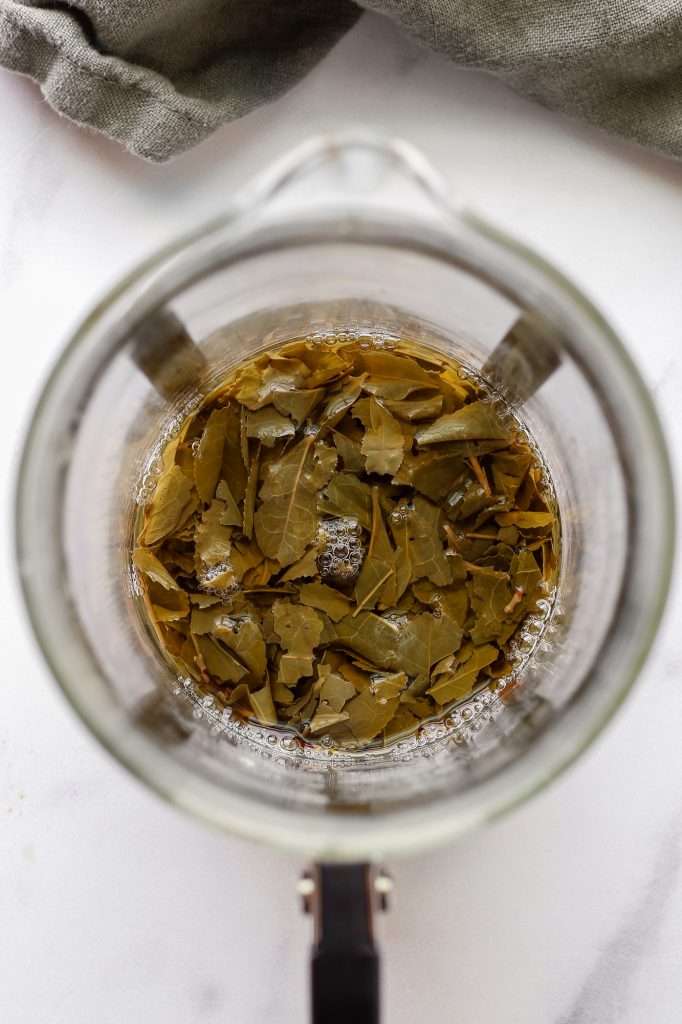
Using LMNT Electrolytes to Flavor Kombucha
I don’t know if you have ever lived through a south Louisiana summer, but the sweating and electrolyte loss are intense. Therefore, I set out to make kombucha guaranteed to replenish my electrolytes even on the hottest days.
What are electrolytes? Electrolytes are charged minerals that conduct electricity to power your nervous system. They also regulate hydration status by balancing fluids inside and outside all the cells in your body.
I use LMNT electrolytes daily, formulated with a science-backed electrolyte ratio of 1000 mg of sodium, 200 mg of potassium, and 60 mg of magnesium. The main reason I supplement my electrolytes is for gut health. Electrolyte balance is essential for optimal gut health, so getting a dose of balanced electrolytes with fermented foods and drinks is a win-win situation.
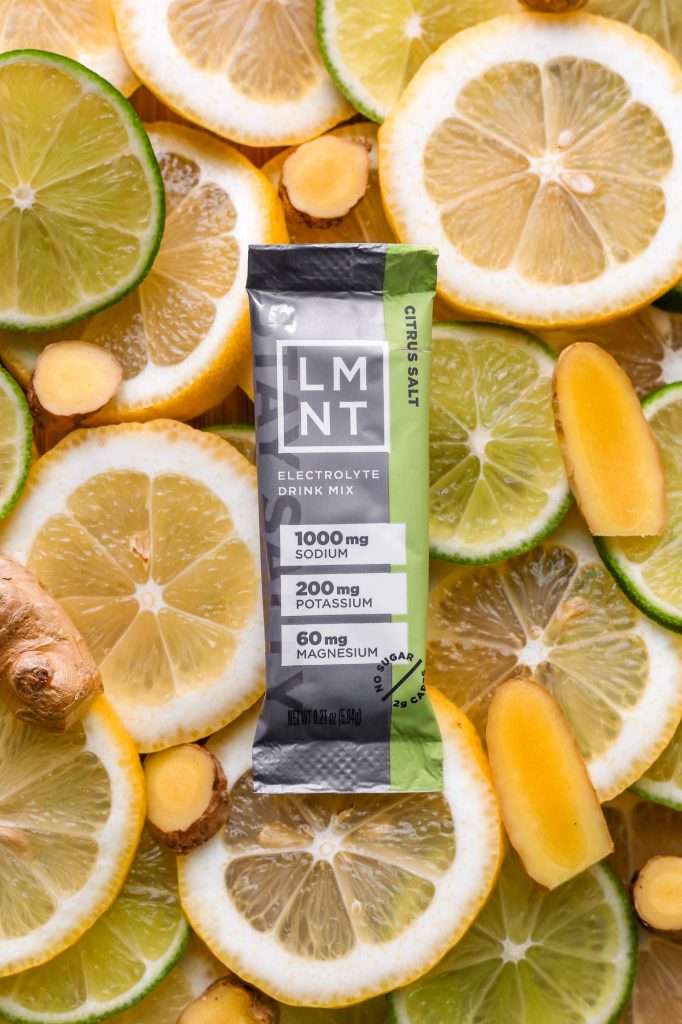
One of my favorite flavors is the LMNT Citrus Salt. Whenever I drink it, I think, “This would be so good mixed with a little ginger!” So that’s what I went with for this kombucha flavor.
The flavor is fantastic, like a zingy and refreshing ginger ale, perfect for poolside sipping. After mowing the lawn and tending the summer garden, it also makes a lovely summer mocktail on the patio.
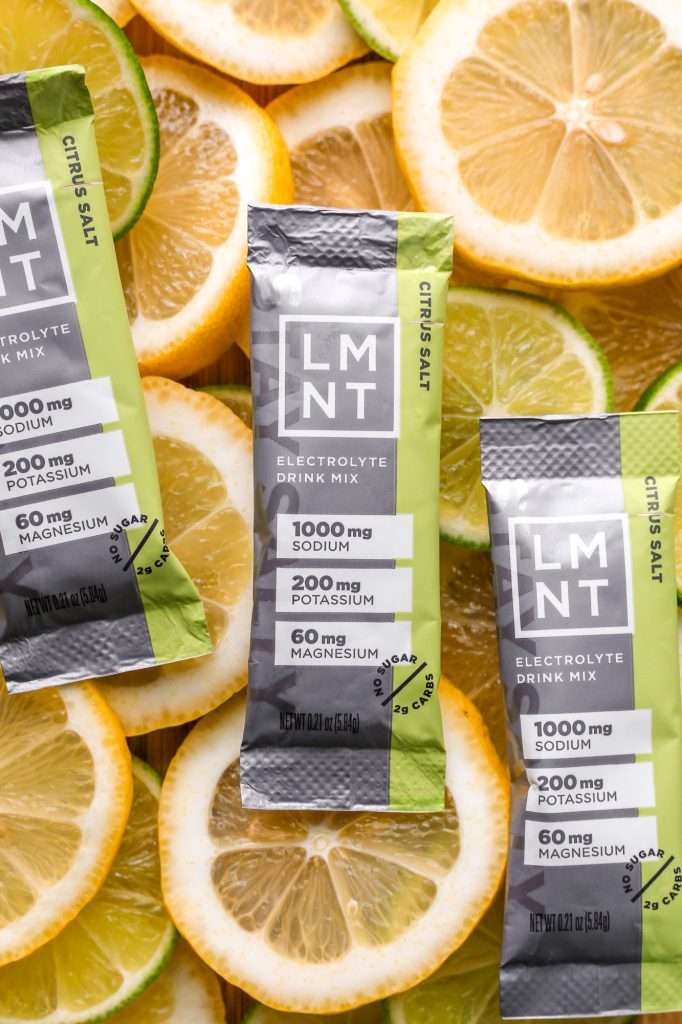
Green Tea Kombucha Primary Fermentation
To learn more about how to grow a kombucha SCOBY, click here.
Kombucha primary fermentation is also known as feeding your SCOBY. Your kombucha SCOBY should be fed fresh sweet tea every 7 days. Some people wait longer to feed again; it depends on the temperature. Anywhere between 7 and 14 days is usually acceptable for primary fermentation.
During primary fermentation, a transparent film will form on the surface of the sweet tea. Do not disturb it; this is the first stage of a new SCOBY forming. Next, the film will get thicker and less transparent. It will start to look opaque and off-white to light brown. The color depends on the type of tea you use. It should not look chalky and will be shiny and smooth.
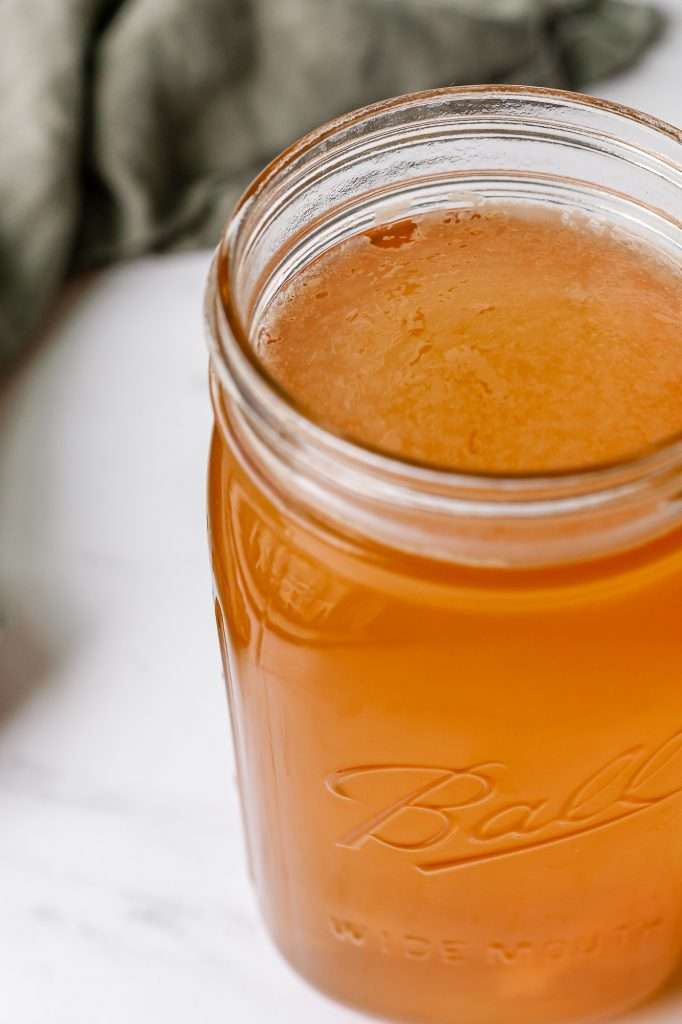
Between 7 and 14 days, you should have a fully formed SCOBY. It may be thin, but it will get bigger the more you make kombucha with it. SCOBYs, on average, are 1/2 to 1 inch thick. After 7 days, the tea is fermented and ready for secondary fermentation.
To quality-control the primary fermentation process, you can test the pH of your kombucha using pH strips. The pH should be between 2.7 and 3.7. The fermented tea should also smell lightly sweet and pleasantly sour.
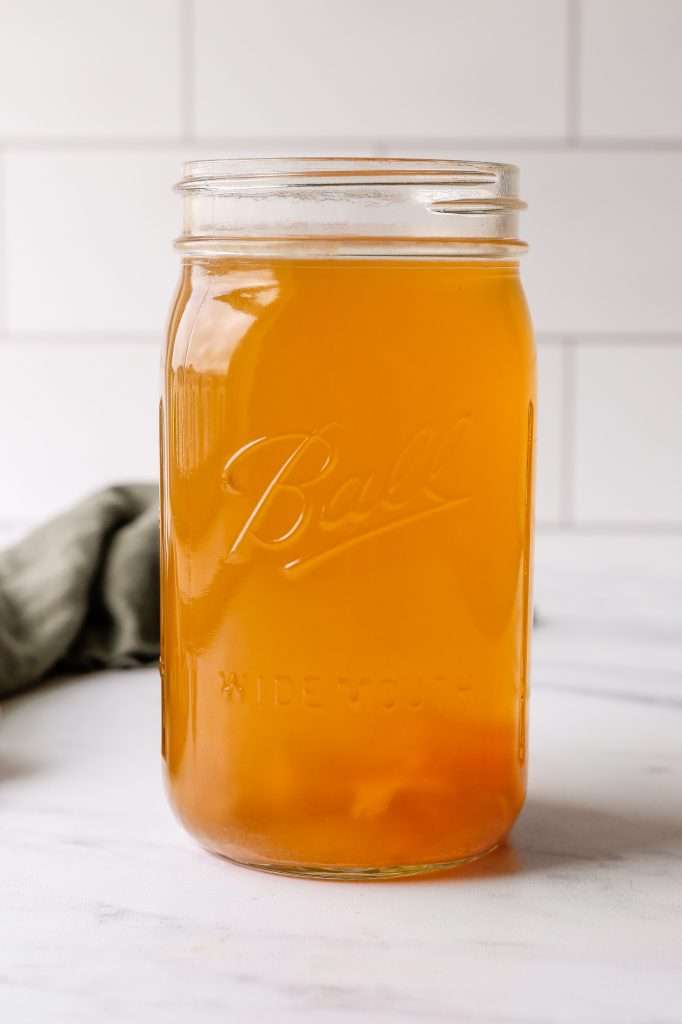
Citrus Ginger Kombucha Secondary Fermentation
For secondary fermentation, the fermented sweet tea is separated from the SCOBY. Then, it is bottled in a carbonation-safe bottle with flavoring such as fruit juice, a packet of LMNT, or both! When I use LMNT to flavor my kombucha, I like to add a little bit of honey (about a tablespoon per 1-liter bottle) to make it extra fizzy.
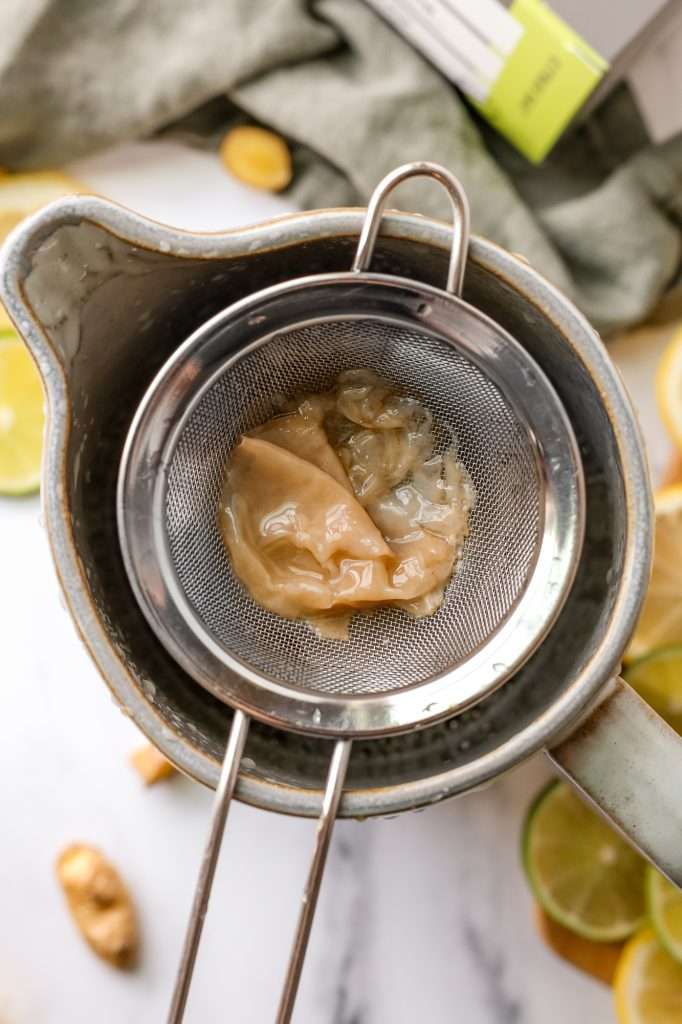
Citrus lends the best flavors for kombucha secondary fermentation. I almost always opt for a citrus flavor or a blend of fruit flavors that includes some citrus. The best LMNT flavors for kombucha are Citrus Salt, Grapefruit Salt, and Mango Chili.
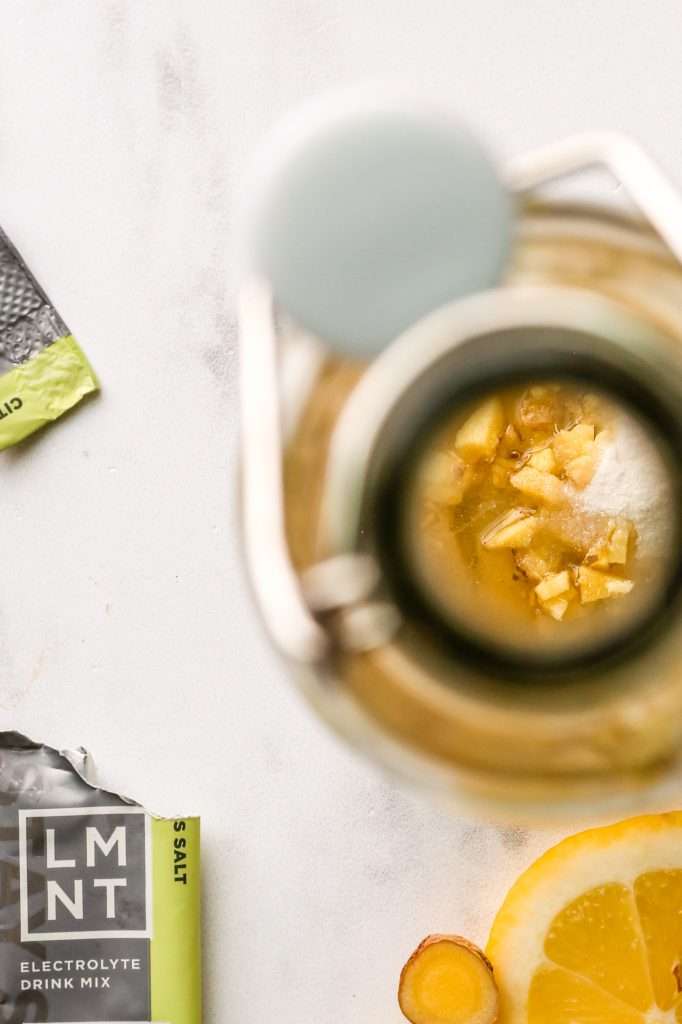
Since the kombucha carbonates during secondary fermentation, you must use carbonation-safe bottles for this step. You can also recycle kombucha bottles from the store for flavoring and bottling.
Supplies You Need to Make Green Tea Kombucha
Here is the equipment you will need to make it:
- 5 grams loose leaf sencha green tea
- 750 grams of boiling hot water
- 50 grams of organic sugar
- 1-quart glass jar
- tight-weave cloth covering and a rubber band
- 1 kombucha SCOBY
- carbonation-safe bottles
- 1 to 2 Packets LMNT Citrus Electrolytes
- fresh ginger
- honey (optional)
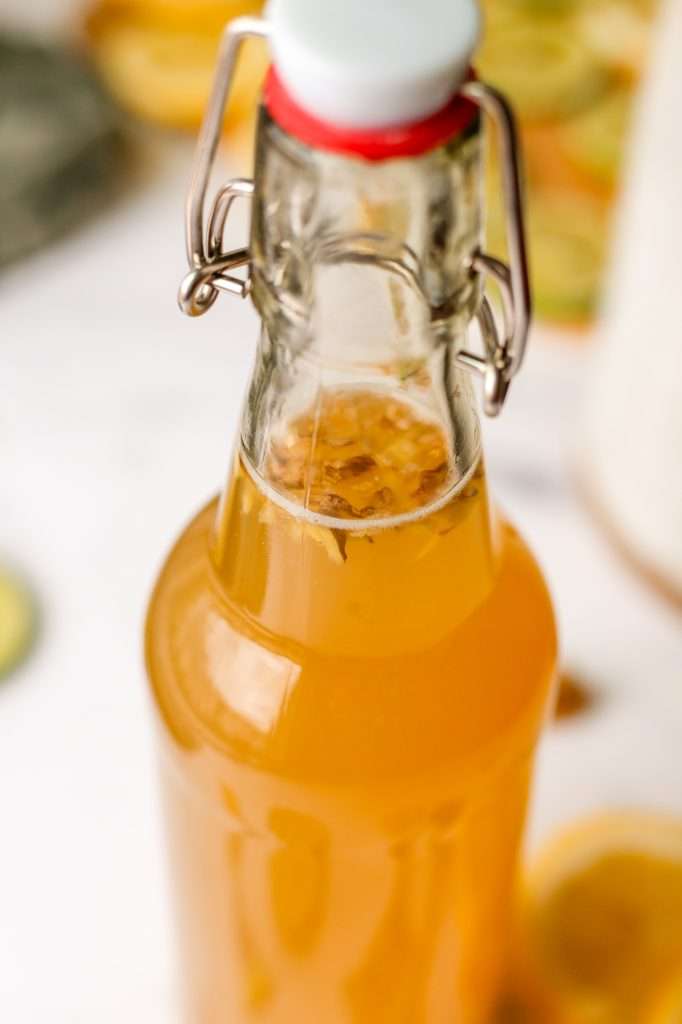
Before purchasing a bale-top bottle for carbonation, verify from the seller that it is pressure-safe and intended for fermentation. Again, I want to mention that you can recycle kombucha bottles from the grocery store for the second fermentation. Since the bottles are designed for high carbonation, they’re safe to use.
Click here to learn about the best tea for kombucha

The Health Benefits of Green Tea Kombucha with Electrolytes
I love LMNT electrolytes and use them daily to stay hydrated in the gym. So, I am thrilled to work with our sponsor, LMNT, to share this information about electrolytes with you!
Here are some of my favorite health benefits that the Citrus LMNT electrolytes add to this highly refreshing green tea kombucha.
- Improve cognitive function: Electrolytes, especially sodium, regulate fluid balance in and around the brain. They also help transmit signals between neurons—which allows us to think. Goodbye, brain fog.
- Fewer muscle cramps: Electrolytes transmit electrochemical signals to your muscles, instructing them when to contract and relax. Improper hydration—a lack of electrolytes—is one of the leading causes of muscle cramps.
- Digestion Regulation: Proper fluid balance and electrolyte intake (especially potassium and magnesium) support healthy digestion. Proper fluid balance and electrolyte intake (especially potassium and magnesium) support healthy digestion. Potassium helps the muscles in the gut contract and push digesting food forward through the intestines, while magnesium helps the muscles ahead of the food relax to allow it through.
- Hydrated Skin: Hydrated skin is happy skin. Since proper hydration is about fluid balance and not just water intake, hydrating with electrolytes can help keep your skin beautiful: fewer cracked lips and dry patches.
- More Energy: Potassium and magnesium support the processes that convert stored energy (calories) into usable energy (ATP). LMNT electrolytes also impact energy by regulating hormones, maintaining fluid balance and blood pressure, regulating heartbeat, promoting restful sleep, and much more. And no afternoon slump means no need for that extra cup of coffee.
- Higher Quality Sleep: Quality sleep is critical to looking, feeling, and performing your best. Magnesium increases GABA, a neurotransmitter known for producing calming effects. Consuming adequate sodium can help you sleep through the night because low sodium levels increase cortisol and adrenaline.

Try LMNT Electrolytes to Flavor Your Kombucha!
Give your green tea kombucha an outstanding flavor and an electrolyte boost! Members of my Cultured Guru Community get a free LMNT Sample Pack with any LMNT drink mix ordered through THIS LINK (CLICK HERE).
- The LMNT Sample Pack includes 8 of our favorite LMNT drink mix flavors. This is the perfect offer for you if you want to explore and find your favorite LMNT flavor or if you want a sample pack to share LMNT with a friend.
- This offer is available exclusively through my partnership with LMNT – you won’t find this offer elsewhere!
- This offer is available for new and returning LMNT customers who click THIS LINK (CLICK HERE); you can get a free Sample Pack with every LMNT order purchased through my link.
- LMNT has a no-questions-asked refund policy. If you don’t like LMNT for any reason, email [email protected]

Citrus Ginger Green Tea Kombucha with Electrolytes
Boost your gut health and get a dose of electrolytes with this refreshing citrus ginger green tea kombucha! This kombucha is made with fresh ginger and all-natural LMNT Citrus Electrolytes, which provide sodium, potassium, and magnesium for effective hydration.
- Prep: 15 minutes
- Cook: 15 minutes
- Total Time: 336 hours 30 minutes
Ingredients
- 5 grams sencha green tea
- 750 grams boiling hot water
- 50 grams organic sugar
- 1 quart glass jar
- tight-weave cloth covering and a rubber band
- 1 kombucha scoby
- 2 tablespoons freshly grated ginger
- 1 packet of LMNT Citrus Salt electrolytes
Instructions
- Gather your ingredients and supplies. Make sure any equipment you are using has been cleaned well.
- Boil your water.
- Steep the tea in the hot water for 5 minutes. If using tea bags, simply remove them. If using loose leaf tea, strain all the tea leaves from the mixture.
- Stir in the sugar until completely dissolved.
- Allow the sweet tea mixture to cool completely. It should be at room temperature before moving on to the next step.
- Once it is cool, add the kombucha SCOBY. Some SCOBYs float, others may sink to the bottom, either way it’s fine.
- Cover the jar with a tight-weave cloth lid and rubber band. You must use a cloth lid to allow oxygen flow.
- Keep the jar of sweet tea with the SCOBY at moderate room temperature, out of direct sunlight, for seven days. The temperature should be between 65 and 78 degrees F.
- After 7 days, you should see a new SCOBY forming on the surface.
- Make a fresh batch of sweet tea as in steps 2-4. Remove the SCOBY from the fermented tea and place it in the jar of fresh sweet tea.
- The fermented tea is now ready for flavoring and bottling (secondary fermentation).
- For secondary fermentation, you need pressure-safe glass bottles. Mix 1 packet of LMNT Citrus Salt, 1 tablespoon honey, and 2 tablespoons freshly grated ginger into the fermented tea.
- Using a funnel, fill the pressure-safe bottles with the fermented tea mixture, leaving a little room for headspace (see pictures above for fill level).
- Once the bottles are sealed, carbonation builds. Secondary fermentation can take anywhere from 5 to 12 days, depending on the temperature. At 5 days, check the carbonation carefully in the sink. If it’s not carbonated enough yet, let it sit undisturbed for a few more days.
- If you love this recipe, please rate it as 5 stars below! Thanks!
Notes
- For a more intense flavor, use 2 packets of LMNT Citrus Salt Electrolytes




















A lot of the recipes that I see for kombucha includes transferring some kombucha from the previous batch into the new batch as the ‘starter tea’. I don’t see that in your recipe is there a reason for/against using starter tea?
you can do that too. “starter tea” and SCOBYs all contain the same microbes.
Such a good recipe. I added a turmeric shot to it for an added immune system boost for the fall season.
Amazing!
Hi! If I have full grown SCOBY that I’ve been feeding with black tea, can I start feeding them with green tea for this?
yep! SCOBYs don’t care, you can change up the tea.